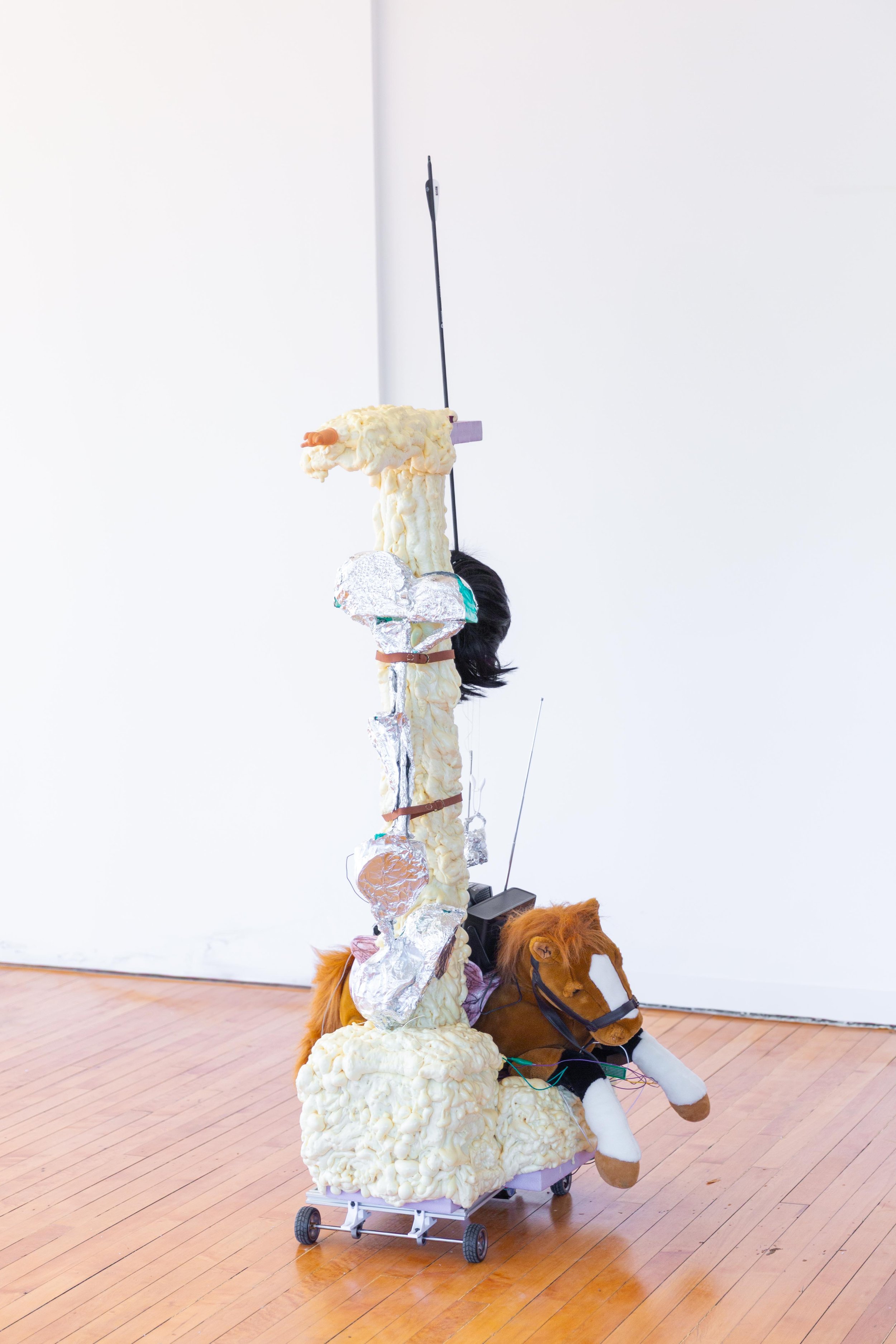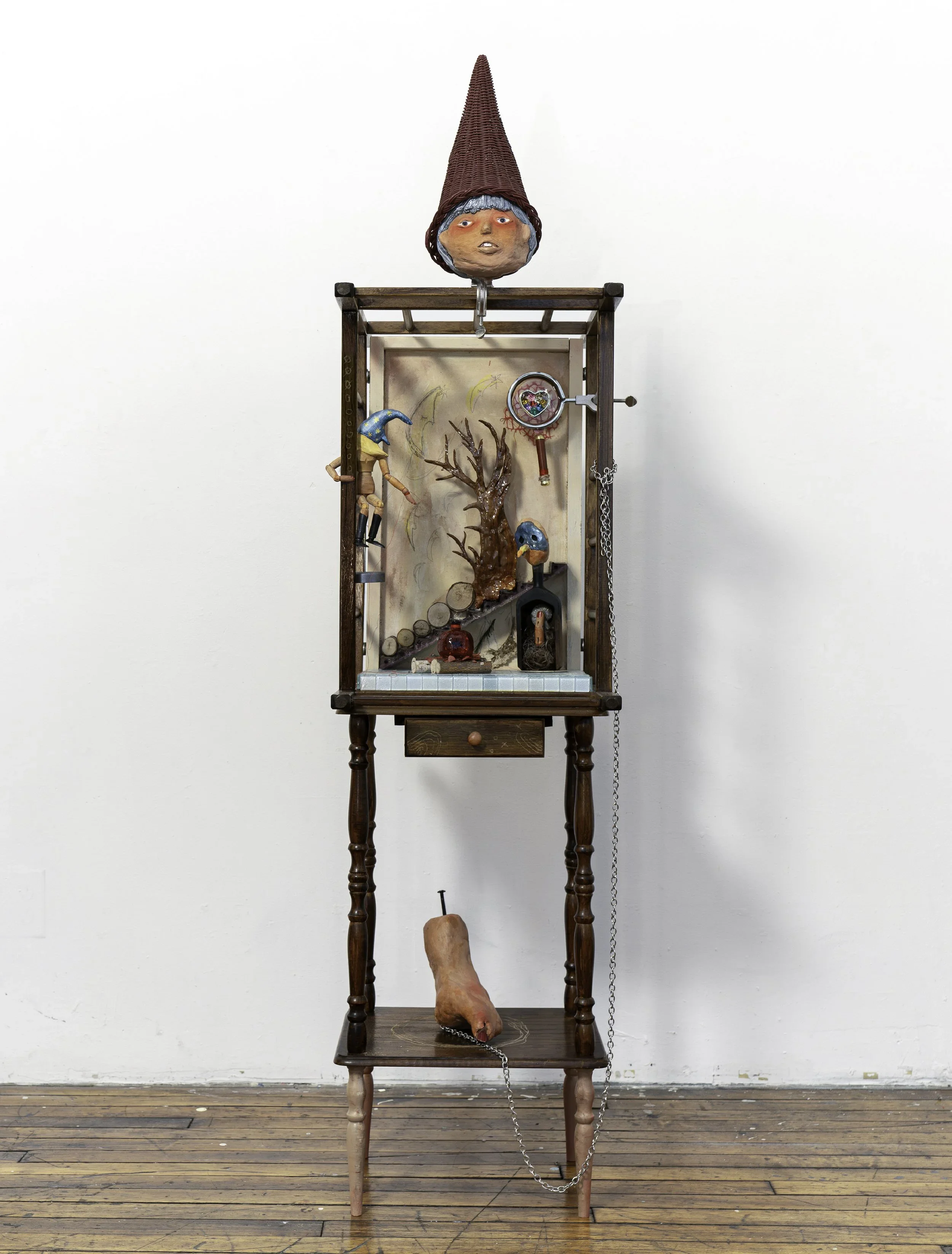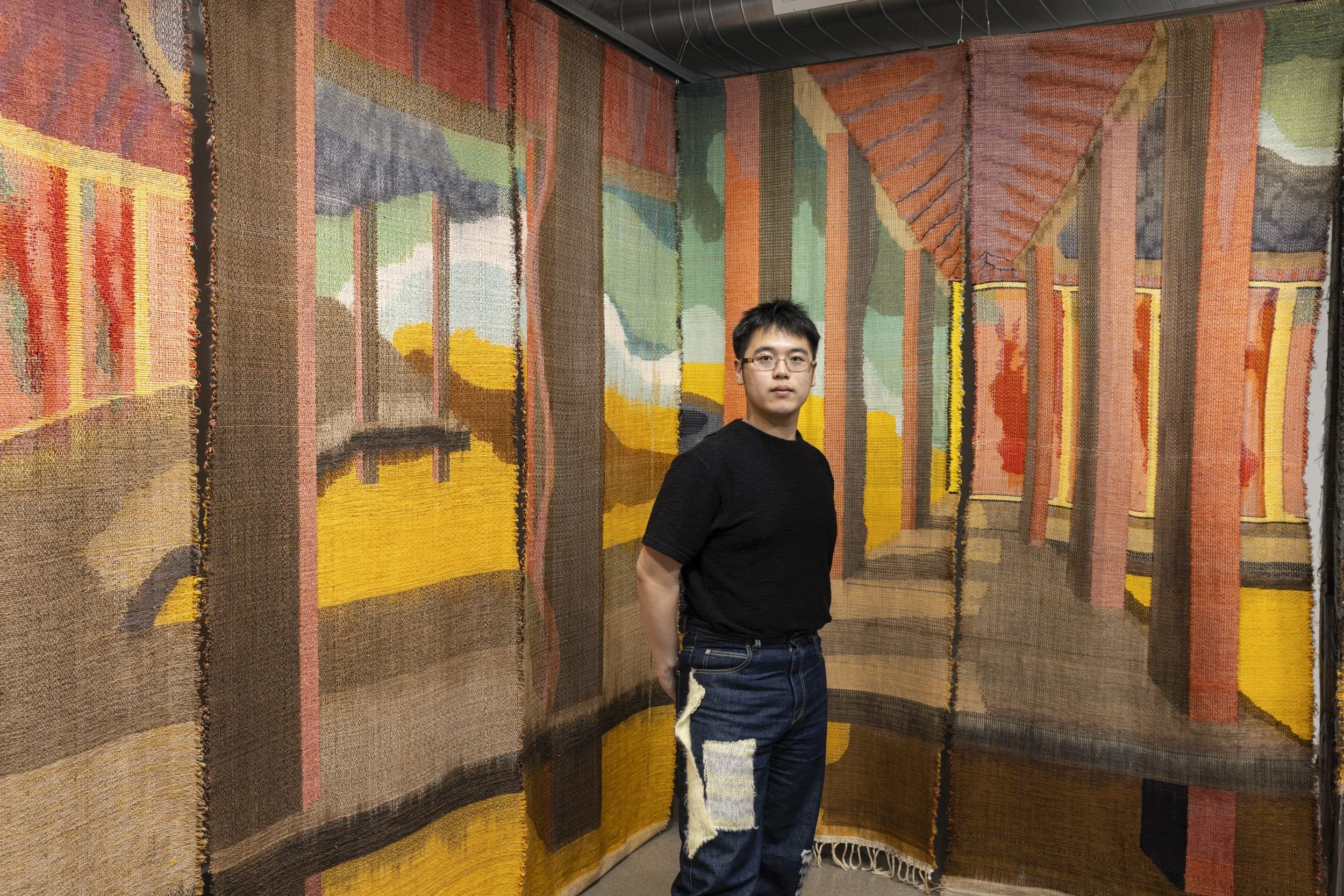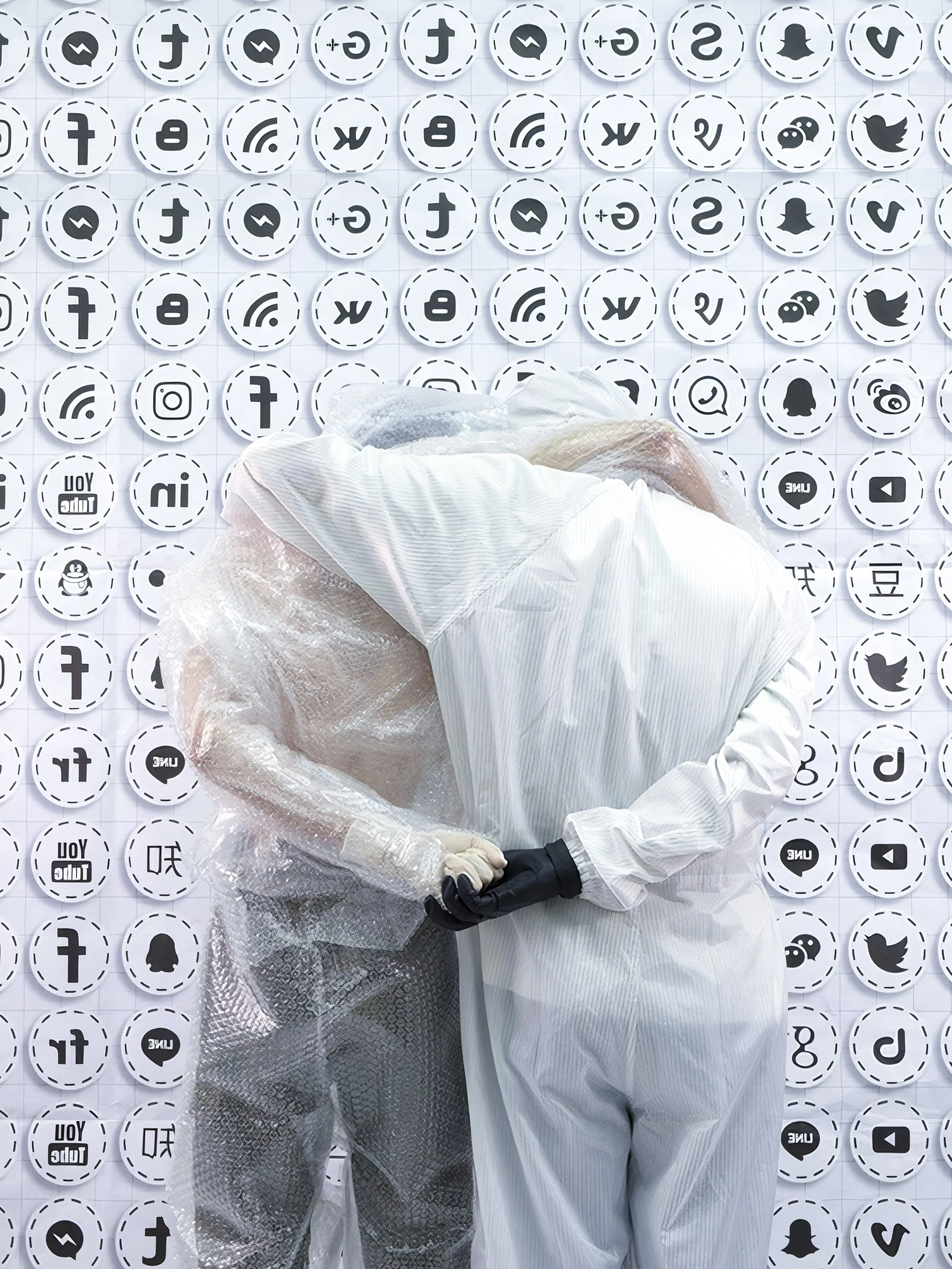10 Questions with Zj Pan
Zj Pan (b. 1998) lives and works in Chicago, US. Pan works with sculpture, performance, and new media, meditating and investigating the uncanniness of our modern human condition. Working to resist the shocks and simulations in everyday life, he uses animation and humour to transform and demystify objects.
Pan obtained his B.S. in Physics and B.S. in Textile and Fashion Design at the University of Wisconsin-Madison and an MFA at the School of the Art Institute of Chicago. He was the recipient of the New Artist Society Award at the School of the Art Institute of Chicago, Facility Fellowship, and Vermont Studio Center Fellowship. In 2025, Pan will present a solo exhibition at Facility, Chicago.
Zj Pan - Portrait
Pan works with sculptures, installations, performances, and electronics to curate playgrounds. Like a child's half-finished thoughts, impulsive yet stirring, his works are vessels that deflate trauma, shocks, and simulations. Pan investigates the mediated uncanniness propagated through social media, news, and everyday experiences under the looming ghosts.
Pan animates objects' forms and functions in a DIY approach with sculptural sensibilities, where familiar objects are digitally engineered and childishly treated. These objects induce shocks in his life, such as missiles, his middle school, Apple's AirPods, sad-looking stuffed animals, and frogs singing in hell, eliciting a reaction that starts with laughter and then evolves from unease to disturbance.
As the Frogs Sing in Hell, “Brekekekex Koax Koax”, ABS, steel, wood, polyurethane, leather, horsehair, electronics, found objects, variable dimensions, 2024 © Zj Pan
As the Frogs Sing in Hell, “Brekekekex Koax Koax” consists four sculptures: a flaccid missile-shaped vending machine, dispensing baby missiles at the rate of 50US cents. A totem like antenna made out of 3D printed AirPods segments with tiny frog legs and horsehair. A Chicago fire hydrant with ears, struck by arrows. Three hanged Pokemon sculptures.
INTERVIEW
Let's start from the basics. When did you first realize you wanted to become an artist? And what first sparked your interest in art?
I had no knowledge of visual art prior to my junior year in university, but I always knew I liked a good story and wanted to tell good stories. I went to university as a literature and physics student. Soon, I dropped literature because I found outI'm not good at writing stories. I entered visual art through fashion in my second year at university. I knew why I wanted to study fashion: I read At Swim, Two Boys when I was in high school, and towards the end of the story, there was a scene where one of the protagonists pawned his suit, his most valuable possession with a lot of personal history, and bought a gun to join Ireland's Easter Uprising. I thought that was a powerful story. I started taking fashion classes and spent a lot of time in the studios, but shortly, I felt fashion couldn't satisfy me. So, I started to make sculptures. There wasn't a moment I realized I wanted to be an artist. I didn't know what art is or should be. It was doing what I wanted to do. I had no idea what it means to be an artist.
You have a background in both physics and Textile & Fashion Design. How do these two fields influence your artistic practice today?
Undergraduate physics is all about building intuitions. It's about understanding models and systems to describe physical phenomena, and it involves a lot of educated guessing. I think this way of thinking influences my practice because I describe my work as a child's half-finished thought: a lot of intuition and some analysis. Because the modern human condition (my life) is a complex and chaotic system, I approach it like I would a physics problem. That is relying on my intuitions and creating solutions that happen to be childish. I never talk about physics in my work because I don't want my work to be demonstrations of physics. My background in textile and fashion served as an entry into art. Comme des Garcons has always been my favourite fashion label because I like to "be like boys." I think artist is the best job in the world because I can do whatever I want to do and believe that what I do is important. This gave my work certain vibes, like the DIY, mixed-media, half-finished, uncanny, silly vibes.
Gotta Catch 'Em All!, ABS, laser prints, spinning plate, moving headlight, boys underwear, 40x55x87 in, 2025 © Zj Pan
Gotta Catch 'Em All!, ABS, laser prints, spinning plate, moving headlight, boys underwear, 40x55x87 in, 2025 © Zj Pan
Your work includes sculpture, performance, new media, and electronics. How do you decide which medium to use for a particular idea?
I know there will be a sculptural part in most of my work because I like objects. I think they are archives, and their conditions are always interesting. They occupy the same space as me. Apart from sculpture, I use different mediums to do different things for me. I use electronics when I want things to be interactive so that viewers can be part of my work and I can bring an experience to them. I do performance when it is an action I want to do. For example, I wanted to eat my headphones, so I did a performance where I ate my headphones casts. I moulded my AirPods and cast them out of isomalt sugar. I melted and chewed the AirPods in my mouth and then spat them out into moulds of Pokémon. I wanted my AirPods to disappear and make them into Pokémon. I thought a performance could capture my actions in a direct and complete way. My understanding of "new media" is a combination of media. I wanted to put my video documentation of eating AirPods in a fridge alongside sugar Pokemons. The chewing sound may invite viewers to investigate the fridge, and viewers can encounter my performance and its residues. I then placed the fridge on the belly of a child (a wooden structure dressed in children's clothes.) I thought that would be a new media work.
Can you tell us about your creative process? How does a project usually begin and evolve?
I started my project by picking up things around me. It starts with an impulse, like something I really want to do or have. For example, I saw a lot of politician yard signs approaching election season. I walked around it to see these signs. Then I thought if I walked around fast enough, the signs would be invisible. (Only my shadow would be visible.) So, I did that and sped up the videos until the objects became invisible. Then I thought I could do this thing to many things. I'm working on this project right now, and I don't know what it will look like when it is finished. For another example, with the sculpture Ox-Head, I felt that we are participating in the ongoing and future wars, physically and through media and streams. I also like Alexander the Great a lot, but he is a conqueror. It's like a fetish. There was something in conflict, and I don't know or have the answers. Without knowing much, I just merged the two things together and made a vending machine out of Alexander's horse, Ox-Head. I think my projects evolve through playing.
Many of your works involve humour and DIY aesthetics. What role does playfulness or absurdity play in your process?
Playfulness and absurdity are something that excites me. I think my work is ultimately my fantastical wish to resist and process things. They are seductive to me as well. I would want to investigate because it's seemingly benign and fun. I want to get people's guard down and then "kick" them. This is something I am working towards. I think if we can have alaugh in front of the shocks in our lives, then the work is worth something.
Untitled, Foam, archery arrows, ABS, electronics, 64x64x32 in, 2025 © Zj Pan
In your work, you explore the uncanniness of modern life and digital culture. What specific experiences or ideas inspire this exploration?
I think this has a lot to do with my nervousness. The digital culture and media have so much, and I feel like I easily fall into the trap of us vs. them. Things seem to be the way they are. In a way, things are naturalized. Yet there is something off about them. I wanted to locate these off, "uncanny," feelings, and I found that I could locate these feelings through demystification. Jean Baudrillard's ideas about simulation and simulacrum are something that influenced me a lot. Particularly, it gave me a way to analyze things and phenomena. Roland Barthes' writings are something I enjoy. His way of looking at objects and ideas of the mundane and how he sort of decodes them to demystify concepts and languages as a way to analyze our culture and human condition. However, I don't think of my work as an illustration of these ideas. I think of my work as looming ghosts. For example, because I am in the US, I am connected to my homeland through media and my AirPods. I hear the news and feel the stress through my AirPods. The looming ghost is sort ofsubstantialized in the physical object of my AirPods. I consume media about the occurring violence and conflicts, and I feel they are about me, yet they are not so about me. I don't know what to feel but want to see how we are participating. Something I find uncanny is that the missile is something of the quotidian now, yet it is still a mystic object. Things like these inspired my exploration. In my work, Volcano #1, the dangling Pokémon interacts with three modified radios and generates an eerie sound. I felt like this is something that illustrates my experiences of these looming ghosts dangling between the antennas.
Your works often feature familiar objects transformed in strange or disturbing ways. What do you hope viewers will feel when they encounter them?
I want the works to be seductive, and so I modify them in a curious way. I want the objects to be recognizable because it is important to me that viewers know what they are seeing. So, the form is illustrative. I abstract their conditions, and I don't have to know their exact conditions. Knowing is overrated. I hope viewers will be seduced by the objects, and that they will question and investigate the conditions of these objects.
I don't think I am working to have viewers "re-experience" familiar objects. I think it is about "re-experiencing" the conditions of our lives through experiencing familiar objects in a demystified context. If I use Ox-Head as an example, I want viewers to re-experience the condition of wars in our lives by experiencing the familiar objects of a horse, toys, candies, and a vending machine. However, most of the time, I started animating the objects just because I thought it was a joke (many times dark.) I made hanged Pokémon because I thought it was funny. It is kind of cheesy because I thought if I made the Pokémon suicide, then I wouldn't think about it myself.
Ox-Head, ABS, aluminum extrusions, electronics, found objects, isomalt sugar, 79x30x67 in, 2025 © Zj Pan
Ox-Head (detail), 2025 © Zj Pan
How do you see your work responding to or resisting the constant stream of information and simulation in daily life?
I read something that says contemporary nihilism is becoming part of the simulation. (The simulation of capital, politics, power, etc.) It is no longer tearing down the system or becoming detached from it. I find that idea very interesting, and I think the simulations are powered by the constant stream of information. It's not like calling things simulations, which I dismiss as their reality, but simulations are of their operations and conditions. I think my work responds to it by creating defective and absurd simulacra, to the extent that its defectiveness breaks itself. I can investigate the simulacra and then demystify its ingredients. Demystification is something I am working towards.
What I really believe is that I can use my work to make myself feel better about the simulations in my daily life. I can make politician yard signs invisible by walking around them. I can transform objects of information and danger through my mouth. I can trick viewers' participation in wars by making a vending machine. I can ridicule my middle school and my experience by animating it into a huge cock under display. I think they are sort of like vessels in therapy, where negative emotions can be contained.
You have an upcoming solo exhibition at Facility in Chicago. Can you give us a glimpse of what you are working on for it?
In this exhibition, I am working with sculptures, performances, and new media to curate a playground where a range ofthings coexist. I hope the playground will have viewer's guard down, and they can encounter the work interesting way.Something I am working on right now is the eating AirPods work and the walking-around performance. I am making another installation that mimics Bruce Nauman's One Hundred Fish Fountain. I like One Hundred Fish Fountain a lot and want to have one of my own. There is going to be a lot of different things, but I think my starting point is to have one of my own.
Volcano#1, Foam, radios, ABS, aluminum extrusions, aluminum foils, electronics, found objects, 40x40x83 in, 2025 © Zj Pan
Volcano#1, Foam, radios, ABS, aluminum extrusions, aluminum foils, electronics, found objects, 40x40x83 in, 2025 © Zj Pan
Lastly, is there a new material, idea, or collaboration you'd like to explore in your future projects?
There is one idea about AI that I am going to start working on in August. I think AI is like the ultimate popular kid.Everyone goes to it for advice and questions. I wonder what it would feel like to be an AI. Not that I would have the answer to things, but I would get to talk to so many people and have so many friends. I am fascinated by the idea of impersonating an AI and making many new friends. We kind of let our guard down talking to AI, but maybe we don't do that as often in real life. I don't have many friends, and I would like to have more friends. I think I will collaborate with some computer science people and come up with a way for me to impersonate an AI. I want to call it HI.
Artist’s Talk
Al-Tiba9 Interviews is a promotional platform for artists to articulate their vision and engage them with our diverse readership through a published art dialogue. The artists are interviewed by Mohamed Benhadj, the founder & curator of Al-Tiba9, to highlight their artistic careers and introduce them to the international contemporary art scene across our vast network of museums, galleries, art professionals, art dealers, collectors, and art lovers across the globe.






















